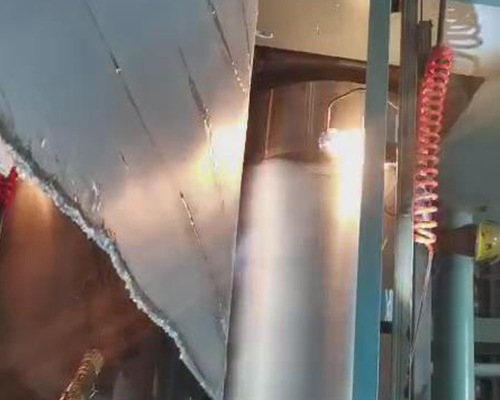The size of the gap in nozzle and roller has a great influence on the longitudinal streaks.
In normal production, due to the assembly error of the nozzle or the poor quality of the nozzle, the gap in nozzle and roller is too small or partially uneven. The powders ground by the nozzle after the roll and the casting nozzle are in contact, and the inclusions such as aluminum slag during the casting and rolling process will accumulate at the outer tip of the nozzle. When the aluminum liquid passes through, the crystallization conditions here are different from those in other places. There are obvious differences in crystallization conditions. On the surface of the cast-rolled coil, an obvious structural difference is formed due to different crystallization conditions. If this difference is serious, it will produce cleaning rod defects. If it is slight, vertical stripes will appear.
After the longitudinal stripes are generated, they will be printed on the same position of the roll, and gradually form a small, uneven sticky aluminum strip along the circumference of the roll. Due to the interaction between the roll and the cast-rolled coil, it is difficult to eliminate the longitudinal stripes online. Sometimes runs through the entire length.
On the basis of adjusting other process parameters, the gap in nozzle and roller was increased by 0.1 mm.
The test proves that there are almost no stripes on the surface of the cast-rolled billet, the longitudinal stripes have been well controlled, and the surface quality of the billet has been greatly improved. However, when the gap between the nozzle rolls is too large, the oxide film at the gap between the nozzle rolls is easily broken and rolled to the board surface, forming oxide film folding defects. In severe cases, the oxide film ruptures and causes aluminum leakage, so be cautious to increase the gap between the nozzle rollers.
The surface features of the longitudinal stripes are defects that run through the entire length along the length of the cast-rolled sheet. The longitudinal stripes are bright bands, sometimes deep. The longitudinal stripe will form a corresponding stripe in the circumferential direction on the surface of the casting roll, which must be polished with sandpaper during production. Longitudinal stripes cannot be eliminated on the surface of the foil. When the longitudinal stripes are severe, bright and dark stripes appear on the surface of the foil, which seriously affects the surface quality and product quality of the foil.
By increasing the gap between the casting roller and the casting nozzle, and optimizing the nozzle flow pattern, the longitudinal stripes on the cast-rolled sheet surface are reduced or eliminated.

